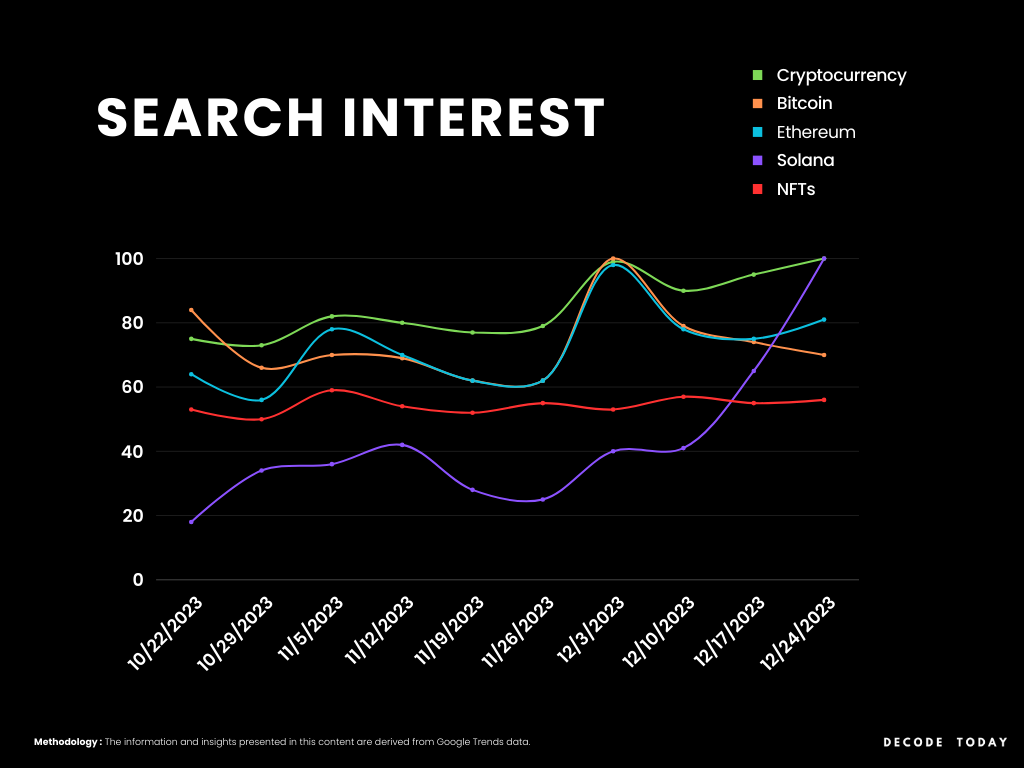Crypto Search Interest Surges, Similar to 2020

Cryptocurrency is back in the spotlight, echoing the excitement of 2020. According to Google Trends data, there has been a notable upswing in online searches related to “crypto” and “cryptocurrency.” These search volumes have soared similar to the peak of the previous significant surge, evoking a sense of heightened interest and curiosity in the digital currency space.
From the early 2010s to the present, search interest in cryptocurrencies has experienced several notable phases. The first significant uptick occurred around 2013, when Bitcoin’s price surpassed $1,000 for the first time, attracting widespread media attention and curiosity. Another major surge came in late 2017 and early 2018, during the infamous crypto boom when Bitcoin approached $20,000, and many altcoins reached all-time highs. This period marked a peak in search interest as global media coverage brought cryptocurrencies into mainstream conversation.
Search interest in cryptocurrencies, as reflected in online search data, often correlates with adoption rates. A spike in searches typically coincides with increased curiosity or concern among the public, prompting more individuals to explore and potentially invest in cryptocurrencies. For example, during significant market events like Bitcoin’s price surges or major regulatory announcements, there is usually a noticeable increase in both search queries and subsequent adoption activities, such as new wallet registrations or heightened transaction volumes. This pattern suggests that search interest can serve as an early indicator of growing adoption, with heightened online activity translating into tangible market participation.
The relationship between search interest and crypto adoption also influences investor behavior and market entry. Increased search activity can lead to a higher number of first-time investors entering the market, driven by FOMO (fear of missing out) or curiosity about recent trends. This influx of new participants often affects market dynamics, as fresh capital enters the ecosystem, potentially driving up asset prices.
Additionally, heightened search interest can influence existing investors’ decisions, prompting them to adjust their portfolios based on perceived market sentiment. Overall, search interest serves as both a reflection and driver of market dynamics, impacting how investors engage with the cryptocurrency space.

How Crypto Search Interest Has Changed?
Big names in the crypto realm, such as Bitcoin and Ethereum, seem to be undergoing a momentary pause. Despite the sustained enthusiasm in the broader crypto market, these leading digital currencies are currently experiencing a temporary slowdown or revaluation.
Solana, the blockchain underdog that’s suddenly the talk of the town. Its search term has skyrocketed in recent weeks, leaving Bitcoin and Ethereum in its dust. What’s behind Solana’s meteoric rise? Recent airdrops, particularly the memecoin Bonk, have played a starring role. The massive airdrop campaign fueled a surge in Solana’s daily active addresses and price, highlighting the power of community engagement and token distribution strategies.
But not everything is on the rise. NFTs, once the stars of digital art, are not getting as much attention lately. As the initial fervor subsided, the market witnessed a correction, prompting a decline in overall interest in NFTs. The surge in prices and subsequent market saturation with less-than-stellar projects led to a degree of skepticism among investors and enthusiasts alike. The prevailing sentiment suggests that the NFT space is undergoing a necessary correction, akin to the settling of exuberance and speculation, paving the way for a more sustainable and discerning phase in its development.
Despite the current dip in attention, it’s essential to acknowledge that the fundamental technology underpinning NFTs remains promising. NFTs operate on blockchain technology, providing a secure and transparent way to represent ownership of unique digital assets. This technology has far-reaching implications beyond the world of digital art, extending into areas such as gaming, virtual real estate, and even intellectual property rights. The decline in interest is, therefore, not indicative of a fundamental flaw in NFT technology but rather a recalibration of market dynamics, separating the wheat from the chaff and allowing for a more mature and robust NFT ecosystem to emerge.
Should Search Interest Data Be Used for Analysis?
Relying solely on search interest as an indicator for cryptocurrency market movements or overall interest in the crypto space can be problematic for several reasons. Firstly, search interest data provides a snapshot of online activity but lacks the context needed to understand the underlying reasons for the interest. A spike in searches could be due to positive news, negative events, or even simple curiosity about a term or event unrelated to investment intentions. Without understanding the context, it’s challenging to draw accurate conclusions about market sentiment or future behavior.
Additionally, search trends can be influenced by non-market factors, such as media coverage, viral news, or social media trends, which might not correlate directly with actual investment actions. For instance, a celebrity mentioning Bitcoin could lead to a surge in searches without necessarily indicating a substantial impact on market dynamics or long-term investor interest. Furthermore, search interest often reflects past or present curiosity rather than proactive engagement with the market. By the time search data indicates a trend, the market may have already moved in response to underlying factors like regulatory changes, technological developments, or major transactions, making reliance on search data alone a reactive rather than proactive approach.
Search interest data typically does not provide detailed demographic information about who is searching, which means it’s challenging to gauge whether the interest comes from new investors, seasoned traders, or individuals with no intent to engage in the market. Understanding the demographics behind the searches is crucial for interpreting the data’s relevance to market movements. Moreover, search interest does not account for crucial financial metrics such as trading volume, liquidity, market capitalization, and investor sentiment surveys, which are essential for a comprehensive market analysis. For a well-rounded perspective, search interest should be considered alongside these quantitative indicators.
Finally, cryptocurrencies are highly volatile, and short-term fluctuations in search interest may not align with long-term trends or investment opportunities. Investors and analysts need to look beyond immediate data spikes to understand broader market cycles and fundamental factors driving the market. In summary, while search interest can offer valuable insights into public awareness and emerging trends, it is essential to use it in conjunction with other data points and analyses to avoid potential pitfalls associated with relying solely on a single source of data.
Stay informed with Decode Today! Subscribe for the latest updates on global news, businesses, market trends, technology, and the economy.
Disclaimer: The content provided on this site is not intended as investment advice. Always conduct thorough research and consider seeking advice from a qualified financial professional before making any investment decisions.
